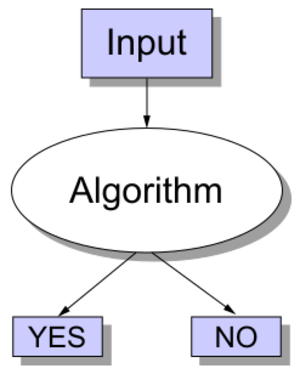Decison problem facts for kids
Imagine you have a question that can only be answered with a simple "yes" or "no." In the world of computers and math, this kind of question is called a decision problem. It's a special type of problem where, no matter what information you put in, the answer will always be either "yes" or "no." Think of it like a switch that can only be on or off, or a light that is either lit or dark.
These problems are super important in areas like computability theory and computational complexity theory. These fancy terms basically mean studying what computers can and cannot do, and how quickly they can do it.
Contents
What is a Decision Problem?
A decision problem is a question asked within a formal system. A formal system is like a set of rules or a language that computers and mathematicians use to solve problems. For example, "Is this number even?" is a decision problem. If you give it the number 4, the answer is "yes." If you give it 7, the answer is "no." The answer always depends on the specific information you give it.
Why are they important?
Decision problems help us understand if a computer can actually solve a certain type of problem. They also help us figure out if there's a step-by-step method (like a recipe) that a computer could follow to get the "yes" or "no" answer.
Can computers always decide?
Not all decision problems can be solved by a computer, even in theory! Some problems are called undecidable. This means there's no way to create a program or a set of rules that will always give you a "yes" or "no" answer for every possible input. It's like asking a question that has no definite answer, no matter how smart you are or how powerful your computer is.
An example of an undecidable problem is the Halting problem. This problem asks if you can create a computer program that can tell, for any other program, whether that program will eventually finish running or if it will run forever. It turns out, you can't!
Examples of Decision Problems
Many everyday questions can be thought of as decision problems.
Simple Math Questions
- Is this number prime? (Yes/No)
- Is this number greater than 100? (Yes/No)
- Does this equation have a solution? (Yes/No)
Computer Science Questions
- Is this word spelled correctly? (Yes/No)
- Does this computer program contain a virus? (Yes/No)
- Can a path be found between two points in a map? (Yes/No)
These types of problems are fundamental to how computers work and how we design algorithms (step-by-step instructions for solving problems). By understanding decision problems, we can better understand the limits and possibilities of what computers can achieve.


